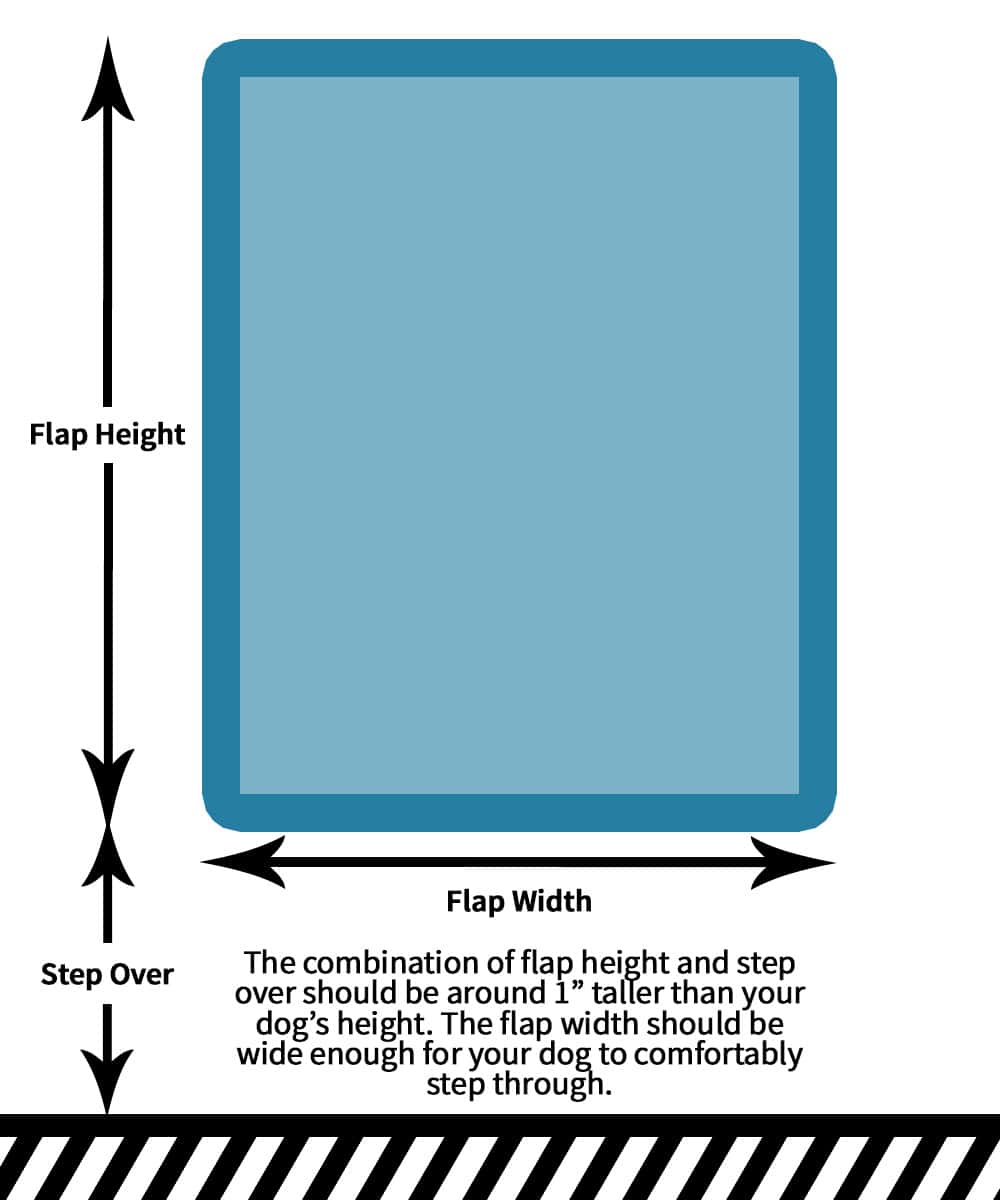Quick Overview
- Estimate the width of the door by measuring across your dog’s shoulders and adding a few inches for safety.
- Estimate the door height by measuring from the floor to your dog’s shoulders, then adding two inches.
- Decide on a “step over” of the door – the height from the floor to the bottom of the door – that is comfortable for your dog. This is usually around 3-5″, but test this with your dog using barriers of various heights.
- Make a test version of the door using cardboard and tape to check that the measurements are correct and that your dog could comfortably use a door of this size.
It’s vital to install the right size dog door. Too big, and you’re cutting a larger hole than necessary, which may compromise the security of your home. Too small, and your dog can’t comfortably move in and out.
Here’s a simple method for deciding what size dog door you need. We’ve also included a brief overview of the pros and cons of a doggie door, with thoughts from IMDT dog trainer Rebecca Morello.
Contents
Basic Dog Door Size Chart
Before you start measuring, it’s important to understand the three crucial dimensions when buying a dog door. They are (see the illustration below for more details):
- Flap height
- Flap width
- Step over
The following sections will show you how to measure each to get the right size door for your pet.
Some door manufacturers provide sizing charts based on weight. While these can be useful as a quick guideline, we don’t recommend relying on weight alone. Dogs of the same weight can vary greatly in body shape depending on the breed.

How to Choose the Correct Dog Door Size
Step 1: Measuring the Width of Your Dog Door
First, you need to figure out the width of the door flap. This can be done by measuring your dog across the shoulders horizontally, and then adding a few inches for safety. You don’t want to oversize the door, but it’s important that your pet’s fur doesn’t catch on the frame.
When measuring your dog’s width, measure their body…not the coat! Measuring your dog’s coat can give you a much wider door than you need.
An alternative method is to use an existing door. Measure how wide it needs to be for your pet to walk through without squeezing.
Step 2: Measuring the Height of Your Dog Door
Next, measure the height of your dog. This should be from the floor to the shoulder or “withers” – not the head. Then, add two inches for safe and easy movement to get the required height of your door flap.
Remember, this is the height of the opening from the bottom to the top edge, not the actual height of the opening from the floor. The overall height of the dog door will need to include the “step-over” or rise of the door.
Step 3: Measuring the Rise of Your Dog Door
The rise or “step over” is the distance between the floor and the bottom of the flap. This is the height your dog will need to step over to get into or out of the house.
The height of the door flap plus the height of the step over should be around 1″ taller than the height of your dog (from step 1). The step over should also be comfortable for your pet to walk over without hurting their joints, forcing an unnatural body position, or causing them to crouch too low.
There is no precise way to measure the step over. Most dogs are comfortable with a three to five-inch step over, but this varies depending on age, size, and health issues. It’s a good idea to ask your dog to step over barriers of various heights to get a feel for what they are comfortable with.
Also, remember that stepping over something high will get harder as your pet ages, so you may want to go lower in preparation for that time in their life. If your dog has arthritis or other joint issues, the step over will also need to be lower.
Step 4: Other Things to Keep in Mind
Before you start cutting holes in your house, it’s probably a good idea to check your measurements by mocking up a test version from cardboard and tape. Your pet must be able to get in and out easily, without a whole lot of extra space.
Remember, you can put the door in a wall instead of the door, but you’ll need a barrier to seal up the space between each side of the wall. There’s also the option of putting the door in a glass door – although you may need professional help.
Finally, don’t overlook modern locking mechanisms, particularly RFID ones that respond to your pet’s collar. The last thing you want is a human intruder, a neighbor’s pet, or even a wild animal coming through the door that’s supposed to be just for your dog.

Choosing a Door is Just the Beginning
Once you’ve installed a dog door, the next step is teaching your pet how to use it. Confident dogs may walk straight through, but others will need help and encouragement.
Don’t force your dog to use the door before they are ready. Instead, practice luring them through with treats and praise, until they feel comfortable using it.
It’s also important to understand the pros and cons of a dog door. “A doggie door can be helpful in some situations, such as senior dogs who need the toilet regularly or a nervous rescue dog who may prefer keeping to themselves initially,” says Rebecca Morello, IMDT dog trainer.
“However, access to the garden without supervision could risk your dog eating toxic plants, digging holes, or excessively barking,” she adds. “It also makes it difficult to toilet train a puppy because you won’t always know when to reward them for toileting.”
Of course, a doggie door also doesn’t replace a walk, mental stimulation, or giving your dog attention. “Dogs are very social animals and can become distressed and bored without human company,” says Morello.
Summary
There’s a lot that goes into choosing the perfect size doggie door. But if you follow these steps, you should be able to get a door that’s the right size for both your pet and home.
Just remember that giving your dog access to the garden doesn’t mean they can be left alone for many hours. Dogs are social animals that thrive on love, care, and attention.
We hope this article has helped you decide what size dog door you need. If you have any questions, please let us know in the comments section. You may also want to read our guide to dog proofing a fence.


